National Cambridge Collectors, Inc.
A non-profit 501(c)(3) organization.

Evolution Of The Cambridge Swan Molds
by Clyde E. Ingersoll - Crystal Ball #202 - February, 1990
I would like to preface this article with a little personal
information: my wife and I are swan collectors, not specifically
CAMBRIDGE. Our collection started with the rescue of three glass
swans (they turned out to be L.E. Smith) from the junk bin of a
house we moved into while I was a student at the University of
Michigan at Ann Arbor, Michigan, about 1951 or 1952. They were
pretty lonely for about twenty years when my wife started more
serious collecting. When she got about a hundred, she asked me to
catalog them to minimize buying duplicates (cataloging them
didn't help, we still bought duplicates). She got her first
CAMBRIDGE swan (a 3" Type III in late emerald, with a paper
label, in 1971.
In cataloging her collection, I got interested and began
studying. I was mostly interested in glass, although, name it and
we probably have a swan in it. I became an N.C.C. member in 1981
(I just checked my CRYSTAL BALLS to find out when).
This article is the result of examination of CAMBRIDGE, MOSSER,
LEVAY (made by Imperial), CAMBRIDGE by IMPERIAL, and SUMMIT ART
swans in my collection and at the N.C.C. Museum. I asked Phyllis
Smith if an article would be worthwhile and she said yes and
passed by draft along to Bill, who added some exact dates, along
with some other suggestions.
I am especially indebted to Bill for giving me some exact dates
of mold changes. My original premise was that all the molds were
changed at the same time. After finding that this was not the
case, some restudying of my collection brought about some changes
in my conclusions and quite a change in the draft article.
We speak of Type I, Type II and Type III Swans. I don't know if
anyone has defined what is meant by the three Types. I hope this
article will give a definition, but it may not coincide with
present conceptions. I will state the definition, as I see it,
after I have given the EVOLUTION, as I see it, with the facts I
have available. (I didn't expect to come up with the length that
this article has turned out to be.)
The sizes of swans made by CAMBRIDGE starting in December 1928
were: 3", 4 1/2", 6 1/2", 8 1/2", 10" and 13", measured from tail
to breast. (I do not follow this way of measuring in my
collection. I measure the overall length in centimeters.) In
either case, the size obtained is taken as a nominal value
because the swans varied both in body length and overall length
according to the amount of distortion, or shaping, that was
produced while the glass was still hot. There is, of course, more
variation in size when the overall measurement is taken because
of the amount of head/ neck adjustment while the glass was still
pliable.
CAMBRIDGE introduced the swans identified by mold number only.
In subsequent catalogs, they were identified by their various
uses, as well as mold numbers.
- 3" 1040* individual mint/nut; ash tray
- 4 1/2" 1041* candy dish
- 6 1/2" 1042* mayonnaise or candy dish
- 8 1/2" 1043* celery holder or bon bon
- 10" 1044* table decoration (1052 flower pot (apparently w/an insert)
- 13" 1045* table centerpiece
- 4 1/2" 1050* candle holder (new plunger ordered 4-4-52, but 1928 catalog shows candle holder)
- 10" 1052* flower pot (apparently with an insert)
- 16" 1221 punch bowl and cup (introduced in 1937)
- 8 1/2" 1492 candy box or bon bon w/cover introduced
1-6-37 (thanks to article by Carl Beynon,
CRYSTAL BALL April 1989). Cover mold was junked in early 1940s WWII scrap drive
* = Introduction: Fall 1928, page 52.
The introductory design was the swan mold currently called Type
I
TYPE 1-3": 1928 - 1933
TYPE I - Other Sizes: 1928 - 1939
All sizes of the Type I swan were the same design, but execution
was slightly different. Some of the larger sizes have a lack of
symmetry; the 8 1/2" swan has 11 large wing feathers on one side
and 9 on the other. The 4 1/2" has 11 and 10. Only the 3" has 10
on each side. The obvious feather of all Type I molds is the
feather detail, not only on the large feathers, but on smaller
wing, breast and tail feathers.

Figure I
Feather Detail of Type I, 8 1/2" Swan
In the catalog reprints from the National Cambridge Collectors, we find the following:
- January 1930 catalog, page 48: Type I swans in sizes 3" to 13"
- Early 1931, page 31-17: Type I - 8 1/2" swan
- Early 1933, page 33-30: Type I - 8 1/2" swan; Type II - 3" swan, mold #1040 1/2
- 1937 catalog pages from C.B., October 1985: Type
II - 3" swan (designated #1040 possibly in error (?)
as Type II is #1040 1/2); Type 1 - 4 1/2" to 13" swans - 1-23-39 mold order books: "change all swans to be like #1043 (8 1/2" sample)" (details removed)
We can conclude from these entries that the change from Type I to Type II of the 3" swan occurred in 1933. The mold order book entry indicates that the change from the original, for other sizes, took place in 1939. It may be assumed that the original 3" mold was also changed at the same time, even though it had not been used since 1933.
TYPE II - 3": 1933 - 1939
The reworked Type I 3" (#1040) was apparently never used by
CAMBRIDGE, but was sold to IMPERIAL with the other CAMBRIDGE
molds. When IMPERIAL went out of business, this mold was
purchased by BOYD'S CRYSTAL ART GLASS and used to make many
colors not made by CAMBRIDGE.
The 3" Type II (1040 1/2) was a new mold, with somewhat
different design. It had the C in a triangle mark. It featured
somewhat spread wing tips and the large wing feathers were more
"swept back." A deep notch separated the tail from the wings. A
feature of the 3" Type II was a "dimple" in the wings and the
area around the dimple was a "mottled" effect, without the
"blister" effect found on other sizes. The Type II 3" swan was a
little longer, measured tail to breast, but it was still called a
3" swan and the mold number was 1040 1/2 (although later the 1040
number appears again, possibly by mistake: the 1949 catalog
carries a reprint page from the 1940 catalog).
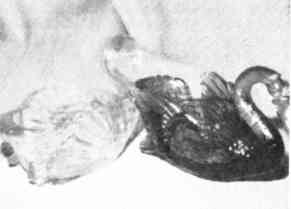
Figure 2
Type I and Type II 3" Swans
Some of the differences between Type I (1040) and Type 11 (10401) can readily be seen:
| Type I | Type II |
| no notch | notch between tail and wings |
| flat tail surface | fan like tail |
| upright major wing feathers | swept back major wing feathers |
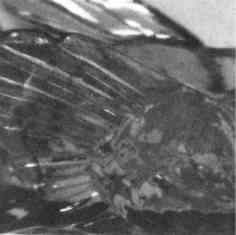
Figure 3
Type II - 3" Mold #1040 1/2
For some of the other features of the Type II take a closer
look:
The detail of the major wing feathers consist mostly of a
central spine for each feather. The balance of the wing is an
indistinct pattern - simply "lumpy." The wing includes a
"dimple."
TYPE II - Other Sizes: 1939 - 1940
The other sizes were reworked in 1939 (rework order of 23 Jan.
1939). The reworking consisted of removing feather detail, which
left the large feathers with only outline and smooth rounded
surface within the outline. The under-tail feathers became
"blister" shape. Most of the neck was made smooth. The mold mark
(C in a triangle) was removed by polishing it away. In the 4 1/2"
and 6 1/2" molds, however, the polishing away was incomplete, so
the C and the triangle can still be discerned on some swans made
in these molds. Milk glass swans that I have in the 4 1/2" and 6
1/2" sizes do not have any vestige of the mark, and 6 1/2" swans
made by IMPERIAL do not have any vestige, so it must have been
completely removed at a later date.
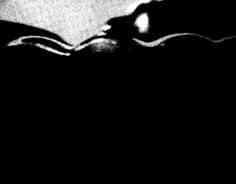
Figure 4
Feather detail of Type II 8 1/2" smooth feathers of reworked
mold
Comparing Figure 4 with Figure 1, the difference is obvious;
all feathers have lost their detail. I have not seen any pictures
or catalog pages from the Jan. 1939 - Feb. 1940 period. Bill says
that there was no Type II in the larger swans. This is a question
of definition of the Types. Bill says they went from Type I to
Type III in the larger than 3" molds. If we define Types simply
by change in the product, the 1939 change would have resulted in
a Type II. If there was a Type II, they were made only for a
short time (possibly a year); they would have been the same in
shape as those made presently by BOYD and SUMMIT. IMPERIAL also
made some in this configuration for LEVAY. I have three 8 1/2"
swans that might be identified as Type II: two crown tuscan and
one carmen. There appears to be no flare. Maybe Bill and I can
get together and compare swans as well as notes.
In the catalog reprints from the National Cambridge Collectors,
we find the following:
- February 1940 mold order books: "make plugs to flare the wings on all size swans".
- June 1949, page 19: #1221 punch bowl (drawing, not a photo) seems to be Type II (no flare).
- June 1949, page 21: a catalog page of "smoker items" shows a 3" (1040) still in Type II. (Bill tells me that this page is a reprint of a 1940 catalog, so this would be misleading in dating the change.)
- June 1949, page 23, 31: other catalog pages of the same date shows 5 sizes, all Type III and the page titled "Swans." The 3" can be identified as Type III because of the "blister" effect feathers on the wing. Again the 1040 designation is used for the 3" mold.
- August 1949, page 152, 152-B: Type III shown in the 3", 6 1/2" and 8" sizes.
- The 3" again identified as 1040.
From these entries, we can conclude that the change from Type
II to Type III took place in 1939 for the 3" swan; the Type III
apparently reverted to the #1040 mold designation.
If there was a Type II in larger sizes, the change to Type III
took place in 1940 after the flaring tools were made.
TYPE III 3": 1939 - 1958
The Type II 3" #1040 1/2 mold was reworked and apparently
returned to the #1040 mold designation. It is not this simple,
however. We could have another type, a Type IIIA (reworked Type
II, 1939 - 1940) and Type IIIB (reworked Type II with flare, 1940
- 1958). Type IIIA was made in the reworked Type II mold. Type
IIIB was made in the same mold, but with the spreader. Type IIIB
had a further spreading of the wings and wider internal dimension
due to the use of the new plug, so that the cavity was closer to
round instead of oval as in Types I and II. Type III, the
reworked Type II, with or without the spreader, was also a little
longer from tail to breast, it also had the "blister" shaped
feather structure on the breast and under the tail. The "dimple"
in the wing was removed forming the "blister" shaped feather
detail on the wings where the "dimple" had been. The neck was
smoothed. The large wing detail was removed so the feathers were
like the larger size swans. The tail was made more round instead
of squared off as in Type II. The "C in a triangle" mark was
removed.
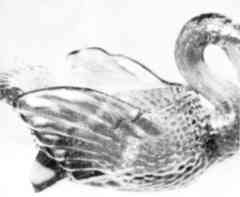
Figure 5
Type III 3" swan showing details different from Type
II
Figure 5 shows the change made from the Type II:
The central spine has been removed and the major feathers are
convex rather than flat as in Type II. The "dimple" has been
removed. The detail of small wing, breast and under-tail feathers
is "blister" shape as with the larger swans. The "fan" shaped
tail is more rounded instead of squarish at the top as in Type
II.
The distinction between Type IIIA and IIIB is not as obvious as one might think. When a group of Type III swans is put on a table together, they can be distinguished, but when observed one at a time, as when buying, it is not so easy. Particularly, if you find a MOSSER swan. The biggest problem is distinguishing between unmarked MOSSER and Type IIIA. The key to the distinction is mold wear. During many years of usage certain defects appeared in the mold. A small projection on the swan's left foot, and the left foot became broader; the difference in width of the left and right feet is quite obvious. Less obvious is a mold closure defect in front of the swan's right wing (on marked MOSSER swans, this defect seems to have been fixed). This reworked mold, with its defects due to long use, without the "spreader plug" is the one obtained by MOSSER. On the other hand, the CAMBRIDGE Type IIIA was made in the newly reworked mold. It has been said that the elder MOSSER obtained it when he left CAMBRIDGE GLASS. It has been used by MOSSER for many colors similar to ones used by CAMBRIDGE as well as many other colors. MOSSER made swans with this mold without the flaring tool, since 1960 without any marking. In the early 1980s, a mold mark was added; "M in an Ohio outline."
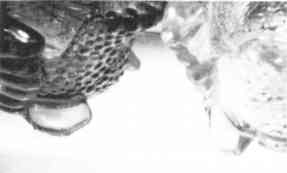
Figure 6
left: MOSSER left foot right: CAMBRIDGE Type IIIA
Note the projection on the MOSSER swans foot. I have been using this projection as a guide to MOSSER swans for a long time. But the more definitive factor is the width of the foot; particularly in comparison with the right foot. The right foot didn't "grow" in the same manner as the left. The Type IIIA feet are both the same size. Also, I have seen MOSSER swans with the projection removed.
TYPE III - Other Sizes: 1940 - 1958
For the other sizes, the change from Type II (if there was a
Type II) to Type III consisted of a manipulation after the swan
was removed from the mold; while the glass was still pliable, a
flaring tool was forced into the back of the swan to bend the
"feathers" outward. IMPERIAL used the flaring tool for swans they
made and labeled "CAMBRIDGE by IMPERIAL." They did not use the
flaring tool for swans they made for distribution by LEVAY.
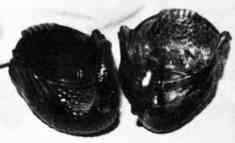
Figure 7
Comparison of swans made with and without the flaring tool -
both by IMPERIAL
According to N.C.C.'s reproduction of the CAMBRIDGE catalog of 1949 thru 1953, (the N.C.C. Color book indicates that milk glass was produced only from February 1954 to the plant closing in July 1954) swans in milk glass had different mold numbers:
- 3" - W94
- 4 1/2" - W95
- 4 1/2" candle - W98
- 6 1/2" - W96
- 8 1/2" - W97
- 16" punch - W99
- punch cup - W100
Although the mold numbers are different, the molds used for
the items that I have seen are the same molds.
DEFINITION: There are two possible definitions of the Types:
1. Whenever the product changed, a new Type was formed. The result of this definition would be four types for 3":
- I - Original #1040
- II - New mold #1040 1/2
- III - Reworked #1040 1/2 mold
- IV - Reworked mold with flaring tool
Three Types for larger sizes:
- I - Original
- II - Reworked mold
- III - Reworked mold with flaring tool
2. Types were defined by new or reworked mold: Three types for 3":
- I - Original #1040
- II - New Mold #1040 1/2
- III - Reworked #1040 1/2 mold (with or without the flaring tool)
Two Types for larger swans:
- I - Original
- II - Reworked mold (with or without the flaring tool)
I tend to favor the second definition as more in keeping with what I believe is the common perception.
SUMMARY:
3" Swan - #1040
- December 1928: Type I introduced
- 1933: modified but not used
- 1958: sold to Imperial
- 1985: sold to Boyd Crystal Art Glass (all swans made in the mold by Boyd were marked with Boyd's "B in a diamond")
3" Swan - #1040 1/2
- 1933: Type II introduced
3" Swan - #1040
- 1939: Type III developed from Type II
- 1960: obtained by Mosser (swans made in this mold by Mosser were first unmarked, now "M in Ohio outline")
4 1/2" Swan - #1041
- December 1928: Type I introduced
- 1939: feather detail removed to make Type II (were there any made w/o the spreader?)
- 1940: spreader used (mold unchanged)
- 1958: sold to Imperial
- 1985: sold to Boyd Crystal Art Glass (all swans made in this mold by Boyd were marked with Boyd's "B in a diamond")
6 1/2" Swan - #1042
- December 1928: Type I introduced
- 1939: feather detail removed to make Type II (were there any made w/o the spreader?)
- 1940: spreader used (mold unchanged)
- 1958: sold to Imperial; some made for LeVay & crystal & cranberry flashed made as Cambridge by Imperial (label only)
- 1985: sold to Summit Art Glass (first swans made with only a projection (pimple) in center of bottom.)
8 1/2" Swan - #1043
- December 1928: Type I introduced
- 1939: feather detail removed to make Type II (I believe some were made w/o spreader)
- 1940: spreader used (mold unchanged)
- 1958: sold to Imperial; some made, crystal & cranberry flashed made as Cambridge by Imperial (label)
- 1985: sold to Summit Art Glass (first swans made with only a projection (pimple) in center of bottom.)
10" Swan - #1044
- December 1928: Type I introduced
- 1939: feather detail removed to make Type II (were there any made w/o spreader?)
- 1940: spreader used (mold unchanged)
- 1958: sold to Imperial; some made crystal & cranberry flashed made as Cambridge by Imperial (label)
- 1985: sold to Summit Art Glass (first swans made with only a projection (pimple) in center of bottom)
13" Swan - #1045
- December 1928: Type I introduced
- 1939: feather detail removed to make Type II (were there any made w/o the spreader?)
- 1940: spreader used (mold unchanged)
- 1940: still in catalog
- 1949: no longer in catalog; mold may have gone into WWII scrap drive.